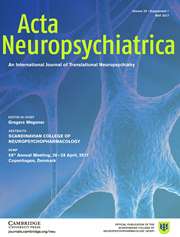Article contents
The Diagnostic Apathia Scale predicts a dose–remission relationship of T-PEMF in treatment-resistant depression
Published online by Cambridge University Press: 02 October 2014
Abstract
The aim of this study was to evaluate the predictive validity of the apathy subsyndrome in patients with therapy-resistant depression in the dose–remission study with transcranial pulsating electromagnetic fields (T-PEMF).
The apathy subsyndrome consists of the symptoms of fatigue, concentration and memory problems, lack of interests, difficulties in making decisions, and sleep problems. We evaluated 65 patients with therapy-resistant depression. In total, 34 of these patients received placebo T-PEMF in the afternoon and active T-PEMF in the morning, that is, one daily dose. The remaining 31 patients received active T-PEMF twice daily. Duration of treatment was 8 weeks in both groups. The Hamilton Depression Scale (HAM-D17) and the Bech-Rafaelsen Melancholia Scale (MES) were used to measure remission. We also focused on the Diagnostic Apathia Scale, which is based on a mixture of items from the MINI and the HAM-D17/MES.
In patients without apathy, the remission rate after T-PEMF was 83.9% versus 58.8% in patients with apathy (p≤0.05). In patients without apathy receiving one active dose daily 94.4% remitted versus 50% for patients with apathy (p≤0.05). In patients without apathy who received two active doses 69.9% remitted versus 66.7% for patients with apathy (p≤0.05).
Taking the baseline diagnosis of the apathy syndrome into consideration, we found that in patients without apathy one daily dose of T-PEMF is sufficient, but in patients with apathy two daily doses are necessary. Including the apathy syndrome as predictor in future studies would seem to be clinically relevant.
Keywords
Information
- Type
- Original Articles
- Information
- Copyright
- © Scandinavian College of Neuropsychopharmacology 2014
References
- 6
- Cited by

